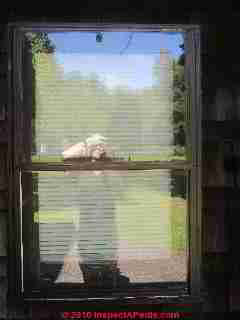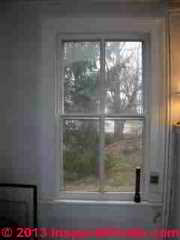 Choices for Plastic Interior Storm Windows: Acrylic & Polycarbonate Plastics
Choices for Plastic Interior Storm Windows: Acrylic & Polycarbonate Plastics
- POST a QUESTION or COMMENT about all types of plastic interior storm windows.
Plastic storm windows installed indoors: a guide to buying, installing, or repairing plastic storm windows.
InspectAPedia tolerates no conflicts of interest. We have no relationship with advertisers, products, or services discussed at this website.
- Daniel Friedman, Publisher/Editor/Author - See WHO ARE WE?
What are the Best Material Choices for Interior Plastic Storm Windows?
[Click to enlarge any image]
Just above: an antique two-over-two wooden window sash on a New York home that would benefit from interior or exterior storm window installation. Our page top photo shows an exterior storm window, photo by DJF. A quick, inexpensive stop-gap measure to cut winter heating bills at homes with windows like this is the installation of a low-cost interior plastic glazing or window covering.
Question: where can I buy plastic window glazing materials?
On a recent trip to the UK I noticed the use of secondary inside storm windows quite a lot. We want to begin manufacturing them here for residential and commercial applications locally. There appear to be U.S. companies that produce similar products, but the shipping costs are prohibitive. We are in the process of choosing an ideal plastic window glazing material; can you help us? Thank You,
Energy Wise, Eugene Mueller G.M., Cuba City WI 53807
Reply: look at vinyl, polycarbonate, and acrylic window glazing options.
The U.S. companies whose plastic storm window glazing we have seen do not identify which plastic they used to produce storm windows, but we consider it likely that most plastic glazing raw materials are widely used in both storm window and solar panel applications.
Some solar panel and storm window cleaning instructions recommend use of a vinyl cleaner - that may be a clue suggesting that you investigate some vinyl based glazing choices as well as acrylic and polycarbonate materials. You may find, however, that many vinyls are prone to scratching and discoloration.
Suggestions for Plastic Window Glazing Choices:
Both acrylic and polycarbonate plastics are suitable for storm window glazing. Our associate Steven Bliss offers this additional advice:
Plastic Choices for Interior storm windows: Plastic is much lighter than glass, easy to cut and drill, and fairly durable, making it a popular material for interior storm windows.
Acrylic Plastic Storm Window Glazing
Acrylic is the most commonly used rigid plastic (as opposed to films) for interior storms. Plastic storm window glazing is sold under a variety of trade names including Plexiglass and Lucite. High-quality acrylic sheeting does not yellow in sunlight, although special high-impact acrylic is more prone to yellowing. Acrylic has moderate scratch resistance, which can be improved with coatings.
Polycarbonate Plastic Storm Window Glazing
An alternative to acrylic window glazing is the more expensive polycarbonate, sold under the brand names Lexan, Makrolon, Hyzoid, Tuffak, and others. Polycarbonate is less breakable and has much higher impact resistance than acrylic, although it is less scratch resistant.
Polycarbonate glazing is used in solar applications because of its high impact resistance, thermal movement characteristics, and resistance to scratching, discoloration, and finally, for its solar transmittance.
Lexan® is approved under most codes for locations in the home or building that require safety glazing. While polycarbonate has a reputation for yellowing under UV exposure, this can be controlled for 10 years or more with additives to the plastic formula. Polycarbonate is also less flammable than acrylic. Some modified polycarbonate plastics come with a 5 to 15 year warranty against yellowing (see excerpt below).
Take a look at POLYCARBONATE GLAZING for details about this material
Other Concerns with Interior Storm Windows
One concern with interior storms in cold climates is the formation of condensation on the primary window caused by moist interior air leaking past the storm window and condensing on the cold primary glazing. This is of particular concern with wood windows, where the condensation can drip down the glass leading to mold and decay of the original wood sash.
Exterior storms, on the other hand, reduce condensation on the primary windows by warming the glass. Also, with exterior storms, condensation can be better managed by weep holes to the exterior.
Excepted from the report: Investigation Of Polycarbonate As A Suitable “Greenhouse” Material For The Solar Cooker, by John Harrison, Florida Solar Energy Center (11/01):
In lighting applications UV is a well known stressing agent of plastics - all transparent plastics will yellow under UV - but it is in many ways the most controllable. Polycarbonate without a UV inhibiting additive will show strong yellowing upon exposure to natural and artificial sources of ultraviolet (such as sunlight and HID lamps). High impact acrylic also yellows, though not to the same degree, and standard acrylic shows little UV induced yellowing. The use of a UV inhibitor in polycarbonate formulation reduces yellowing significantly.
Does yellowing present more than an aesthetically displeasing effect? Strangely, the data are split. Standard falling ball impact tests on polycarbonate indicate that there is no loss of material strength. Furthermore, an ASTM Yellowness Index Rating of 25 for polycarbonate results in a loss in transmissivity of only 5%.
On the other hand, yellowing is a sign of degradation of the plastic molecule. Heat and ultraviolet act to break the molecules. This surrenders the intrinsic strength of the material as the molecular structure no longer consists of long intertwined chains but fractured segments. This may be reflected in reduced strength.
- Steven Bliss, Burlington, VT.
Watch out: we have received numerous complaints of plastic smells or "plastic odors" traced to plastic or PVC replacement window sashes, storm windows, and even plastic window screens.
Details are
at VINYL SIDING or WINDOW PLASTIC ODORS
...
Continue reading at WINDOW EFFICIENCY FEATURES & RATINGS or select a topic from the closely-related articles below, or see the complete ARTICLE INDEX.
Or see these
Recommended Articles
- AIR LEAK DETECTION TOOLS
- ENERGY SAVINGS in BUILDINGS articles on ways to cut heating and cooling costs in buildings.
- STORM WINDOW GUIDE - home
- SPONTANEOUS GLASS BREAKAGE NiS
- STORM WINDOW INTERIOR - energy savings from interior storm windows, how to calculate energy savings from retrofit interior storm windows
- STORM WINDOW PLASTIC CHOICES
- STORM WINDOW WEEP HOLES
- SUNGAIN, FILMS, LOW-E GLASS - for reducing un-wanted window glazing heat gain or heat loss
- VINYL SIDING or WINDOW PLASTIC ODORS
- WINDOW / DOOR AIR LEAK SEALING HOW TO
- WINDOW GLAZING BASED on CLIMATE
- WINDOW INSULATION OPTIONS
- WINDOW SHADING, SCREENING
- WINDOW / DOOR ENERGY EFFICIENT, DOE
Suggested citation for this web page
STORM WINDOW PLASTIC CHOICES at InspectApedia.com - online encyclopedia of building & environmental inspection, testing, diagnosis, repair, & problem prevention advice.
Or see this
INDEX to RELATED ARTICLES: ARTICLE INDEX to DOORS & WINDOWS
Or use the SEARCH BOX found below to Ask a Question or Search InspectApedia
Ask a Question or Search InspectApedia
Questions & answers or comments about all types of plastic interior storm windows..
Try the search box just below, or if you prefer, post a question or comment in the Comments box below and we will respond promptly.
Search the InspectApedia website
Note: appearance of your Comment below may be delayed: if your comment contains an image, photograph, web link, or text that looks to the software as if it might be a web link, your posting will appear after it has been approved by a moderator. Apologies for the delay.
Only one image can be added per comment but you can post as many comments, and therefore images, as you like.
You will not receive a notification when a response to your question has been posted.
Please bookmark this page to make it easy for you to check back for our response.
IF above you see "Comment Form is loading comments..." then COMMENT BOX - countable.ca / bawkbox.com IS NOT WORKING.
In any case you are welcome to send an email directly to us at InspectApedia.com at editor@inspectApedia.com
We'll reply to you directly. Please help us help you by noting, in your email, the URL of the InspectApedia page where you wanted to comment.
Citations & References
In addition to any citations in the article above, a full list is available on request.
- Energy Wise, Eugene Mueller G.M., 314 N. School, Cuba City WI 53807 Tel: 563-542-2134, Email: be.energywise@gmail.com
- Steve Bliss's Building Advisor at buildingadvisor.com helps homeowners & contractors plan & complete successful building & remodeling projects: buying land, site work, building design, cost estimating, materials & components, & project management through complete construction. Email: info@buildingadvisor.com
Steven Bliss served as editorial director and co-publisher of The Journal of Light Construction for 16 years and previously as building technology editor for Progressive Builder and Solar Age magazines. He worked in the building trades as a carpenter and design/build contractor for more than ten years and holds a masters degree from the Harvard Graduate School of Education. Excerpts from his recent book, Best Practices Guide to Residential Construction, Wiley (November 18, 2005) ISBN-10: 0471648361, ISBN-13: 978-0471648369, appear throughout this website, with permission and courtesy of Wiley & Sons. Best Practices Guide is available from the publisher, J. Wiley & Sons, and also at Amazon.com - AAMA, Architectural Aluminum Manufacturers' Association, now American Architectural Manufacturers Association, an " advocate for manufacturers and professionals in the fenestration industry" - website: http://www.aamanet.org/ - Watch out: a search for "what is the effectiveness of storm windows" produced no data although the website suggests that an article is available - web search 06/19/2010.
- Florida Solar Energy Center, 1679 Clearlake Road, Cocoa, FL 32922-5703, E-mail, :
Tel: 321.638.1000
Fax: 321.638.1010. The FSEC is a research institute of the University of Central Florida. Quoting from the institute's website:
Our mission is to research and develop energy technologies that enhance Florida's and the nation's economy and environment and to educate the public, students and practitioners on the results of the research. The Florida Solar Energy Center (FSEC) was created by the Florida Legislature in 1975 to serve as the state’s energy research institute. The main responsibilities of the center are to conduct research, test and certify solar systems and develop education programs. As Florida's energy research institute — with a 35-year history of unique expertise, experience and infrastructure. - Investigation Of Polycarbonate As A Suitable “Greenhouse” Material For The Solar Cooker, by John Harrison, Florida Solar Energy Center [see citation above] (11/01), web search 12/26/2010, original source: http://www.fsec.ucf.edu/en/research/solarthermal/solar_cooker/documents/lexanpaper.pdf
- U.S. Department of Energy, "Energy Efficiency & Renewable Energy - Storm Windows", web search 06/19/2010 - original source: http://www.energysavers.gov/your_home/windows_doors_skylights/index.cfm/mytopic=13490
- Our recommended books about building & mechanical systems design, inspection, problem diagnosis, and repair, and about indoor environment and IAQ testing, diagnosis, and cleanup are at the InspectAPedia Bookstore. Also see our Book Reviews - InspectAPedia.
- "Wonder Windows, Two Let In More Sun, Two Keep In More Heat", V. Elaine Smay, Popular Science, April 1982
- In addition to citations & references found in this article, see the research citations given at the end of the related articles found at our suggested
CONTINUE READING or RECOMMENDED ARTICLES.
- Carson, Dunlop & Associates Ltd., 120 Carlton Street Suite 407, Toronto ON M5A 4K2. Tel: (416) 964-9415 1-800-268-7070 Email: info@carsondunlop.com. Alan Carson is a past president of ASHI, the American Society of Home Inspectors.
Thanks to Alan Carson and Bob Dunlop, for permission for InspectAPedia to use text excerpts from The HOME REFERENCE BOOK - the Encyclopedia of Homes and to use illustrations from The ILLUSTRATED HOME .
Carson Dunlop Associates provides extensive home inspection education and report writing material. In gratitude we provide links to tsome Carson Dunlop Associates products and services.


